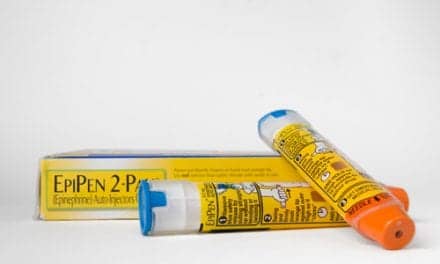Results of a study conducted by pulmonary and sports medicine researchers from Ohio State University suggest an overwhelming majority of National Collegiate Athletic Association (NCAA) sports medicine programs are not adhering to national asthma guidelines established by the National Institutes of Health, which emphasize education, management protocols, and medical professional involvement for their athletes with asthma.
“We wanted to see how well asthma is being managed in athletes competing at the NCAA level,” says lead author Jonathan Parsons, clinical assistant professor of internal medicine at Ohio State University, in news reporting on the study. “Evidence has shown that outcomes are better when an athlete has an asthma attack and the proper help is available.”
To conduct the study, the researchers sent electronic surveys with questions related to the diagnosis and management of exercise-induced bronchospasm (EIB) to 3,200 athletic trainers in NCAA sports medicine programs. More than one fifth of the 541 responses indicated that they had an asthma management protocol at their institution. Slightly more reported having a pulmonologist on staff.
Approximately 17% of respondents reported screening athletes for EIB, 39% indicated a rescue inhaler does not have to be available at all practices, and 41% say that an inhaler does not have to be present at all games.
“Research data supports testing athletes for asthma when it’s suspected, having inhalers immediately on-hand, and asthma specialists as part of their care,” says Parsons.
According to Parsons, athletes often ignore symptoms of EIB, perceiving the condition as an indication of poor performance or simply being out of shape. Additionally, the lead author notes that costs associated with inhalers, staff pulmonologists, and compliance should be viewed as minimal in comparison to protecting the health of our student-athletes.
The report is published in the American College of Sports Medicine’s journal, Medicine & Science in Sports & Exercise.
Urine Test Could Facilitate Diagnosis of Lung Cancer
Why does a history of smoking increase the risk of lung cancer in some individuals but not in others? Researchers from the University of Minnesota think they may be on to something.
At a recent meeting of the American Association for Cancer Research (AACR), Jian-Min Yuan, PhD, MD, associate professor of public health at the university, reported that a history of smoking increases the risk but not in everyone.
Yuan and colleagues hypothesized that it might be the presence of the metabolite NNAL in a patient’s urine that could provide the answer to this mystery.
The researchers collected data from 18,244 men enrolled in the Shanghai Cohort Study and 63,257 men and women from the Singapore Chinese Health Study. They conducted personal interviews to assess levels of cigarette smoking and lifestyle factors. The investigators also collected blood and urine samples from more than 50,000 patients. They then identified 246 current smokers who later developed lung cancer and 245 smokers who did not develop lung cancer during the 10-year period following the initial interviews and collection of urine samples.
Levels of NNAL and nicotine were then calculated: Those with the highest levels of nicotine and NNAL had an 8.5-fold increased risk of lung cancer compared with smokers who had the lowest levels.
According to Yuan, identifying the real culprit among a possible 60 carcinogens in tobacco smoke will make predicting lung-cancer risk more accurate.
Source: American Association for Cancer Research
Philips Respironics Works with Contestants of NBC’s The Biggest Loser: Couples
Philips Respironics, Murrysville, Pa, worked behind the scenes on the seventh season of NBC’s The Biggest Loser: Couples to provide medical equipment, testing, treatment, and therapy for obstructive sleep apnea (OSA). This marked the first time in the show’s history that contestants received comprehensive diagnosis and treatment for OSA.
“It is amazing to see the contestants’ progress to healthier living firsthand and to educate cast and crew about the importance of restful sleep. Being involved in The Biggest Loser: Couples and with the show’s medical team behind the scenes has allowed us to deliver an important health message to contestants, their families, and the viewers,” says Pam Minkley, clinical trainer and member of the on-site Philips Respironics team in an announcement from the company.
Each contestant received an overnight sleep study in the fall of 2008 in a hotel. Sixteen of the 22 contestants were diagnosed with OSA and were given equipment and therapy.
To support this effort, Philips Respironics provided diagnostic tools (ProTech sensors, oximeters, electrodes, and setup materials) and Alice 5 Diagnostic Sleep Systems. Philips Respironics therapeutic equipment—including the REMstar Auto M Series with A-Flex, BiPAP Pro with Bi-Flex, the EverFlo Q oxygen concentrator, and a variety of masks—was also used. Those contestants who were diagnosed with OSA were monitored using EncoreAnywhere with a combination of SmartCard downloads and modems. Philips Respironics continues to provide support on weekly phone consultations to contestants as they leave the show.
On the April 28 episode, Ron, a contestant, mentioned that he has sleep apnea and showed his mask on-air. The full episode was posted to NBC’s Web site.
The Biggest Loser: Couples airs Tuesdays at 8:00 pm EDT on NBC.
Climate Change Likely to Increase Hospitalizations for Respiratory Problems in Children
A recent collaboration between Mount Sinai School of Medicine, NYC, the Natural Resources Defense Council, and Columbia University’s Mailman School of Public Health uncovered eye-opening statistics about the direct connection between climate change and the future health of children.
According to the research team, more children will end up hospitalized over the next decade because of respiratory problems as a result of projected climate change.
Said lead author Perry Elizabeth Sheffield, MD, pediatric environmental health fellow in the Department of Community and Preventive Medicine, “This research is important because it shows that we as a country need to implement policies that both improve air quality and also prevent climate change, because this could improve health in the present and prevent worsening respiratory illness in the future.”
Sheffield and her colleagues created a model describing projected rates of respiratory hospitalizations for children less than 2 years of age using baseline NYC metropolitan area hospitalization rates. According to Sheffield, the hospitalization rates were then compared to a previously developed dose-response relationship between ozone levels and pediatric respiratory hospitalizations and the expected NYC 8-hour daily maximum ozone levels for the 2020s, as projected by a regional climate model created by the NY Climate and Health Project. Two scenarios were used, differing by the amount of projected ozone precursor emissions.
The study found that by 2020, respiratory hospitalizations are projected to rise between 4% and 7% for children less than 2 years of age because of projected air pollution increases. The research team clarified that these are likely conservative estimates because population was held constant, a single dose-response function was used for the entire area, and most counties were not weighted by race and ethnicity.
“Our study supports the necessity of improving air pollution around the world. We need to begin to make these improvements through industry emission controls, traffic reduction policies, and increased enforcement of traffic regulations,” said co-author Philip Landrigan, MD, professor and chair of Community and Preventive Medicine
Even Mildly Premature Infants Have Increased Risk of RSV Infection
A new study from Kaiser Permanente’s division of research finds that even mildly premature infants (gestational ages of 33 to 36 weeks) have an increased risk of medically attended respiratory syncytial virus (RSV) infection.
The study found that babies born at 37 weeks had 37% increased odds of RSV infection compared to babies 38 to 40 weeks, while babies born at 34 to 36 weeks had 70% increased odds. In contrast, babies born at 41 or more weeks had 14% decreased odds.
According to the researchers, the RSV infection risk is higher among infants exposed to supplemental oxygen or assisted ventilation during the neonatal period, but the need for oxygen is sometimes unavoidable for babies in intensive care. Even after controlling for prematurity, babies in the study who received supplemental oxygen during the birth hospitalization had a 50% to 120% increased odds of medically attended RSV infection in the first year of life.
“Although extreme prematurity is a known risk factor for severe RSV infection, this study helped us to learn more about risk factors for RSV infection among mildly premature infants. We detected an increased risk even in babies born at 37 weeks,” said lead investigator Gabriel J. Escobar, MD, a hospital-based pediatrician and research scientist with the Kaiser Permanente Division of Research in Oakland, Calif. “Further research is needed to determine whether strategies to prevent or mitigate RSV infections are indicated in late preterm infants.”
Pharmaxis Releases Positive Results of Phase 3 Cystic Fibrosis Trial
Pharmaxis, New South Wales, Australia, recently released results of its completed international phase 3 trial of Bronchitol in patients with cystic fibrosis (CF). Bronchitol successfully met the primary and key secondary endpoints of the trial.
The primary endpoint of the trial was to assess whether Bronchitol improves lung function as measured by a change in forced expiratory volume in 1 second (FEV1) when administered 400 mg twice per day for 6 months. During the study, patients treated with Bronchitol had a statistically significant improvement in lung function from baseline of 6.6% (P=0.001 versus placebo). Lung function improved at week 6 and was sustained through to week 26.
The key secondary endpoint of the trial was to assess whether Bronchitol further improves lung function in patients already being treated with the most commonly used CF therapeutic, dornase alfa (Pulmozyme™). In patients being treated with concurrent dornase alfa, FEV1 improved after 6 months by 5.2% from baseline (P=0.002 versus placebo).
Over the 6-month treatment period, there was significant lung function improvement for both those patients being treated with Bronchitol and dornase alfa (P=0.008 versus placebo) and those being treated with Bronchitol alone (P=0.015 versus placebo).
Bronchitol was well-tolerated overall in the trial subjects and had a favorable safety profile. There was no difference in adverse events or serious adverse events between the treatment groups. The most common adverse event was cough, which was mild to moderate in most cases and similar between the treatment arms.
The trial included 324 subjects between the ages of 6 and 56 years. The lung function ranges were from 26% to 94% of the predicted FEV1. The randomized, double- blind, placebo-controlled study was conducted in 40 centers in the United Kingdom, Ireland, Australia, and New Zealand. Pharmaxis plans to file a marketing application later this year.
Source: Pharmaxis Ltd










